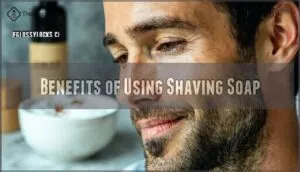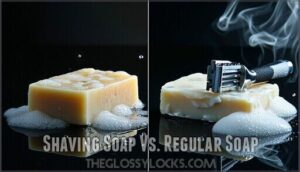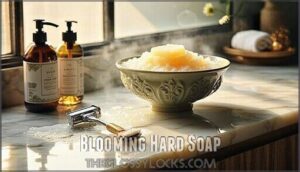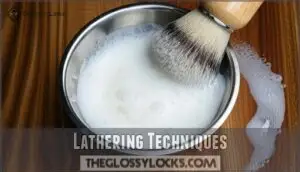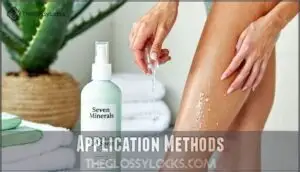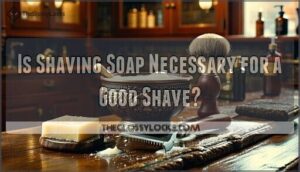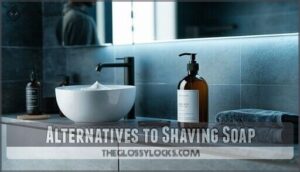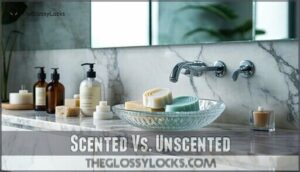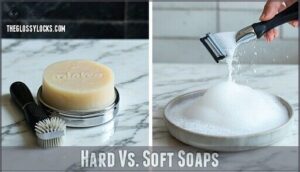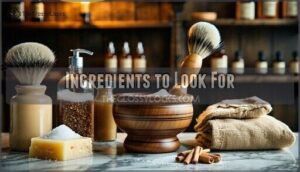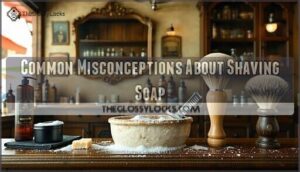This site is supported by our readers. We may earn a commission, at no cost to you, if you purchase through links.
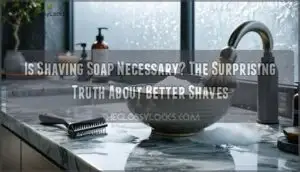
Think of it like cooking pasta without salt – sure, it works, but why settle for bland when you can have better? Shaving soap creates a rich lather that softens your whiskers and cushions your skin, turning your razor into a smooth operator instead of a rough scraper.
Regular soap strips away natural oils, leaving you high and dry. Quality shaving soap actually protects while it works, preventing razor burn and those annoying nicks that make you look like you wrestled with a cat.
The real magic happens in how different soap formulations tackle specific skin concerns, making shaving soap a crucial element in a comfortable shaving experience.
Table Of Contents
- Key Takeaways
- What is Shaving Soap?
- Benefits of Using Shaving Soap
- Shaving Soap Vs. Regular Soap
- How to Use Shaving Soap
- Is Shaving Soap Necessary for a Good Shave?
- Alternatives to Shaving Soap
- Choosing The Right Shaving Soap
- Common Misconceptions About Shaving Soap
- Frequently Asked Questions (FAQs)
- Is a soap bar necessary for shaving?
- Is shave soap better than shaving cream?
- How do I choose the best shaving soap?
- Should you use shaving soap or shaving cream?
- Which soap is best for a shave?
- Do wet shavers use shaving cream or soap?
- Is it OK to shave without soap?
- Is soap necessary for shaving?
- Is it okay to shave with just water?
- Is shaving soap worth it?
- Conclusion
Key Takeaways
- You don’t technically need shaving soap to shave, but you’re missing out on significantly better protection, comfort, and razor glide that transforms your routine from a harsh scrape into a smooth experience.
- Shaving soap creates rich, protective lather that softens whiskers and cushions your skin, while regular soap strips natural oils and leaves you vulnerable to razor burn, nicks, and irritation.
- You’ll save money long-term with shaving soap since one $15 puck provides 200+ shaves at under 8 cents per use, compared to constantly replacing expensive creams and gels.
- You can master shaving soap basics in just weeks – the learning curve isn’t steep, and the two-minute prep time actually improves your razor efficiency and cuts overall shave duration.
What is Shaving Soap?
You’ve probably seen those round pucks of soap in your grandfather’s bathroom and wondered if they’re just old-fashioned relics or actually useful tools.
Shaving soap is a specialized cleansing product made with fatty acids, oils, and moisturizers that creates a rich, protective lather designed specifically for comfortable shaving.
Ingredients
What makes a shaving soap work its magic? The secret lies in carefully chosen shaving soap ingredients that transform your daily routine.
Fatty acids like stearic acid create that rich, protective lather, while glycerin-based formulas deliver superior moisture retention through their humectant properties.
Traditional recipes feature tallow alternatives and natural oils like jojoba or coconut oil for skin conditioning. The saponification process uses lye types such as sodium hydroxide to bind everything together.
One can even create their own using a homemade shave soap.
Key ingredients to look for:
- Stearic acid for dense, stable foam
- Glycerin for moisture retention
- Natural oils for skin nourishment
- Essential oils for fragrance
Understanding these components helps you choose soaps that match your skin’s needs perfectly.
Types of Shaving Soap
Now that you understand what goes into your shaving soap, let’s explore the different types available.
You’ll encounter hard soaps and soft soaps as the main categories. Hard soaps need more elbow grease to create lather but reward you with longevity. Soft soaps whip up quickly with minimal effort.
For a variety of options, consider exploring different hard soap products.
| Soap Type | Lathering Speed | Longevity |
|---|---|---|
| Tallow soaps | Medium | High |
| Glycerin soaps | Fast | Medium |
| Hybrid soaps | Medium | High |
Each offers unique shaving soap benefits for your daily routine.
Benefits of Using Shaving Soap
When you switch from regular soap to shaving soap, you’ll notice your razor glides smoother and your skin feels less irritated afterward.
Think of shaving soap as your skin’s bodyguard—it creates a protective barrier that softens your beard hair while keeping razor burn and nicks at bay, acting as a key component to ensure a smoother shave with less irritation.
Beard Softening
Your beard hair becomes putty in your hands when shaving soap works its magic. The softening ingredients penetrate each whisker, transforming coarse stubble into manageable strands that your razor glides through effortlessly.
Natural beard softener recipes offer similar benefits.
- Hydration importance: Moisture weakens hair structure for easier cutting
- Softening ingredients: Natural oils condition whiskers before shaving
- Benefits of shaving: Reduced tugging means fewer nicks and irritation
Skin Protection
Think of shaving soap as your skin’s bodyguard during each shave.
Its rich lather creates a barrier function that helps prevent cuts and reduce irritation from razor burn.
The soothing ingredients like glycerin provide hydration benefits that regular soap can’t match.
Unlike basic shaving cream alternative options, quality soap shields your face while delivering superior skin protection for healthier results.
Razor Glide
Beyond the surface of your skin, shaving soap creates an invisible shield that transforms razor glide from rough friction into silk-smooth motion.
The dense lather acts like a protective cushion, allowing your blade to float effortlessly across contours without catching or dragging.
- Soap ingredients like glycerin and oils reduce friction between blade and skin
- Lather density provides consistent lubrication that outlasts thin shaving cream alternatives
- Proper skin preparation with quality shaving soap eliminates the harsh pulling sensation
Shaving Soap Vs. Regular Soap
You might think soap is soap, but there’s a world of difference between grabbing that bar from your shower and using a proper shaving soap.
Regular soap creates thin, watery lather that leaves your skin dry and your razor dragging, while shaving soap produces rich, creamy lather that protects your skin and helps your razor glide smoothly.
Lather Quality
Your shaving soap lather quality makes all the difference in your daily routine.
Good lather density creates that perfect cushioning effect you need, while lather stability keeps protection consistent throughout your shave.
Rich lather from quality shaving soap offers superior water retention compared to thin alternatives.
| Feature | Shaving Soap Lather | Regular Soap |
|---|---|---|
| Bubble Size | Fine, dense | Large, loose |
| Cushioning | Excellent protection | Minimal buffer |
| Stability | Stays put | Disappears quickly |
Skin Hydration
When comparing skin hydration benefits, shaving soap outperforms regular soap substantially.
Your skin deserves better than the harsh cleansing agents found in ordinary bars.
| Shaving Soap | Regular Soap |
|---|---|
| Contains moisturizing ingredients like shea butter and glycerin | Strips natural oils from skin |
| Creates protective barrier during shave | Leaves skin tight and dry |
| Suitable for dry skin types with frequent shaving frequency | Can worsen dryness with daily use |
Proper water temperature and hydration ingredients guarantee superior post-shave care and lasting skin protection.
Shaving Comfort
Your shaving comfort dramatically improves when you ditch regular soap for shaving soap.
The difference feels like night and day.
Shaving soap creates a protective cushion that helps minimize irritation, razor burn, and ingrown hairs.
You’ll achieve smooth skin with every comfortable shave thanks to superior razor glide and enhanced skin hydration.
Many users find that natural oils hydrate deeply for smoother skin.
| Aspect | Shaving Soap | Regular Soap |
|---|---|---|
| Protection | Creates cushioning barrier | Offers minimal protection |
| Comfort Level | Smooth, luxurious feel | Harsh, scratchy sensation |
| Skin Condition | Hydrated, nourished | Tight, stripped feeling |
How to Use Shaving Soap
You don’t need a degree in chemistry to master shaving soap, but knowing the basics will transform your morning routine from a rushed chore into something you’ll actually look forward to.
The secret lies in three simple steps that work together like a well-oiled machine: blooming your soap, building a proper lather, and applying it correctly.
Blooming Hard Soap
Blooming hard soap transforms your morning ritual into something special.
Simply cover your shaving soap with hot water for 5-10 minutes while you shower. This blooming time softens the surface, making lathering effortless.
You can find options for purchasing blooming soap online.
- Enhanced fragrance fills your bathroom with luxury scents
- Smoother glide prevents razor burn and irritation
- Richer lather consistency beats any shaving creams you’ve tried
Lathering Techniques
Getting that perfect lather starts with your well-soaked brush. Brush types matter—badger hair holds more water than synthetic.
Use circular motions on the soap, adjusting water temperature to warm. Bowl vs face lathering both work, but bowls give better lather consistency.
If your lather quality seems thin, add more soap. These lathering techniques prevent lather troubleshooting headaches later.
Understanding proper shaving soap creation is key to a successful shave.
Application Methods
Perfect lather means nothing without proper application methods.
Here’s how to transform that rich foam into shaving gold:
- Paint broad strokes across your face with confident brush movements
- Work in circular motions to lift every stubborn hair
- Massage thoroughly for even coverage and better razor glide
- Touch up thin spots before your first pass
Your shaving soap brush becomes your paintbrush for the perfect shave.
Is Shaving Soap Necessary for a Good Shave?
You’ve probably wondered if that fancy shaving soap sitting on the store shelf is just marketing hype or actually worth your hard-earned cash.
The truth is, while you can technically shave with regular soap or even just water, shaving soap transforms your routine from a daily chore into a smooth, comfortable experience that protects your skin and saves you money in the long run, which can be considered a worthwhile investment.
Improved Shave Quality
Shaving soap transforms your routine from rough to refined.
The improved shave quality comes from superior lather quality that cushions each stroke.
You’ll experience enhanced razor glide and shaving comfort that regular soap can’t match.
Proper skin preparation with quality soap optimizes shave techniques, while consistent blade maintenance becomes easier when your razor isn’t fighting poor lubrication.
Skin Health Benefits
Your skin deserves better than razor burn and irritation.
Natural shaving soap delivers serious skin health benefits that transform your daily routine:
- Enhanced skin hydration from glycerin and natural oils
- Reduced ingrown hairs through gentle exfoliation and softening
- Superior skin protection with moisturizing effects for sensitive skin
It’s skincare disguised as shaving prep.
Cost-Effectiveness
Most shavers discover shaving soap’s cost-effectiveness after comparing long-term expenses. While the initial investment seems higher, you’ll save money over time since one puck lasts months with daily use.
Shaving soap is often preferred for its ability to create a rich shaving soap lather that enhances the shaving experience.
- Budget Analysis: A $15 puck provides 200+ shaves versus $50+ for equivalent cream tubes
- Price Comparison: Cost per shave drops to under 8 cents with quality soap
- Economic Benefits: Fewer refills mean less shopping and storage hassle
- Affordable Options: Entry-level soaps start at $8, debunking expense myths
Alternatives to Shaving Soap
You don’t have to stick with shaving soap to get a great shave, since several alternatives can work just as well for your daily routine.
Shaving creams, gels, and oil-based solutions each offer unique benefits that might better suit your skin type, schedule, or personal preferences, making them a viable alternative.
Shaving Creams
Creams squeeze straight from the tube, skipping the lathering ritual entirely.
Cream types range from thick, luxurious formulas to lighter options that create decent foam quality.
While they can’t match traditional shaving soap’s rich lather texture, they deliver a solid shave experience.
Most soap alternatives sacrifice longevity for convenience, making shaving creams a practical middle ground between effort and results.
Shaving Gels
Looking for something quicker than creams? Shaving gels deliver instant Shave Convenience without the fuss.
These Shave Lubricant options glide smoothly across your skin, offering excellent Lubrication Effects.
Here are three popular Gel Types:
- Clear gels – See where you’re shaving
- Foaming varieties – Expand for coverage
- Moisturizing formulas – Include skin conditioners.
Perfect for busy mornings when you need reliable results fast.
Oil-Based Solutions
Think of oil-based solutions as your skin’s best friend during shaving.
Pre-shave oils with jojoba or argan create exceptional skin lubrication, while shaving oils reduce friction dramatically.
These oil types enhance glide enhancement better than traditional products.
Beard growth oil nourishes between shaves, and oil-based balms provide lasting moisture.
Oil-based solutions transform rough shaves into smooth, comfortable experiences.
Choosing The Right Shaving Soap
You’ll find dozens of shaving soaps at the store, but picking the right one doesn’t have to feel like solving a puzzle.
Your skin type, scent preference, and how much time you want to spend lathering will guide you to the perfect match.
You can consider skin type as a key factor when choosing a shaving soap.
Scented Vs. Unscented
Your nose knows what works best for you. Scented vs unscented shaving soap choices depend on your scent preferences and skin needs.
- Fragrance Options – Essential oils offer natural aroma types
- Fragile Skin – Choose hypoallergenic, fragrancefree formulas
- Sensitive Skin – Unscented shaving soap for sensitive skin prevents irritation
- Travel-friendly – Neutral scents won’t clash with cologne
Hard Vs. Soft Soaps
Picking between hard and soft soaps feels like choosing your shaving destiny.
Hard soaps deliver superior razor glide and soap longevity – they’re the marathon runners of shaving soap necessity.
Soft soaps win on lather quality and speed, perfect for shaving soap for sensitive skin.
| Feature | Hard Soaps | Soft Soaps |
|---|---|---|
| Soap Texture | Dense, firm puck | Creamy, malleable |
| Shave Comfort | Excellent glide | Quick, gentle lather |
| Value | Lasts months | Convenient daily use |
Picking between hard and soft soaps feels like choosing your shaving destiny.
Hard soaps deliver superior razor glide and soap longevity – they’re the marathon runners of shaving soap necessity.
Soft soaps win on lather quality and speed, perfect for shaving soap for sensitive skin.
| Feature | Hard Soaps | Soft Soaps |
|---|---|---|
| Soap Texture | Dense, firm puck | Creamy, malleable |
| Shave Comfort | Excellent glide | Quick, gentle lather |
| Value | Lasts months | Convenient daily use |
Ingredients to Look For
The right ingredients separate ordinary soap from exceptional shaving companions.
You’ll want glycerin for its humectant properties, keeping your skin hydrated throughout the shave.
Key ingredients for superior performance:
- Stearic acid – Creates stable, creamy lather with excellent razor glide
- Sodium tallowate – Provides cleansing power and soap hardness
- Natural oils – Coconut and jojoba oils nourish while you shave
- Fatty acids – Essential building blocks for rich, protective lather
When selecting a shaving soap, consider the benefits of shaving soap ingredients to achieve the best results.
Common Misconceptions About Shaving Soap
You’ve probably heard that shaving soap costs too much, takes forever to use, or requires years of practice to master.
These common myths keep many people from trying what could be their best shave yet.
Expense Myths
You’ve probably heard shaving soap costs a fortune, but that’s one of the biggest expense myths in grooming.
Quality options like Williams Mug soap run under $3, while premium brands can hit $100 without justifying the price jump.
Smart budget shaving means avoiding designer markup and choosing cost-effective tallow-based soaps.
Affordable luxuries exist—you just need to know where to look for real value.
Time Consumption
Most people think shaving soap drags out your shaving routine, but that’s pure fiction.
Modern shave prep takes under two minutes once you master basic lathering techniques. Your razor efficiency actually improves with quality lather, cutting shave duration in half.
The rich foam works faster than canned alternatives, and post shave cleanup becomes effortless with proper technique.
Using a pre shave soap can substantially enhance the shaving experience by softening facial hair and reducing irritation, making it a key part of a quality lather and proper technique.
Skill Level Required
Despite common fears, mastering shaving soap doesn’t require razor handling expertise or complex shave preparation rituals.
Basic lathering techniques and application methods create the foundation for success.
While there’s a learning curve with lather control and blade angle, most people nail the fundamentals within weeks.
You’ll discover that shaving techniques become second nature, transforming your routine into an effortless ritual.
Frequently Asked Questions (FAQs)
Is a soap bar necessary for shaving?
Like training wheels on a bike, soap bars aren’t essential for shaving but they’re incredibly helpful.
You can shave with water alone, but specialized shaving soap creates protective lather, reduces irritation, and delivers smoother results.
Is shave soap better than shaving cream?
Shaving soap creates richer lather and provides better skin protection than cream.
You’ll get superior razor glide, longer-lasting results, and often save money.
Cream’s convenience can’t match soap’s performance for serious shavers.
How do I choose the best shaving soap?
You’ll want to take into account your skin type first.
Look for tallow-based soaps if you have sensitive skin, or glycerin formulas for quick lathering.
Test different scents and hardness levels until you find your perfect match.
Should you use shaving soap or shaving cream?
Think of choosing between a Swiss Army knife and a specialized tool.
Shaving soap creates richer lather and moisturizes better, while cream’s convenient but less nourishing.
Your skin’s needs determine the winner.
Which soap is best for a shave?
You’ll get the smoothest shave with specialized shaving soap that creates rich, protective lather. Hard soaps like Martin de Candre offer excellent glide, while soft varieties lather quickly for convenience.
Do wet shavers use shaving cream or soap?
Both options work beautifully in wet shaving.
You’ll find passionate advocates for each camp.
Most wet shavers actually use both—soap for its rich lather and longevity, cream for convenience and quick preparation.
Is it OK to shave without soap?
You can shave without soap, but you’re risking razor burn, cuts, and irritation.
Your skin needs that protective barrier and lubrication.
Water alone won’t cut it—literally.
Skip it at your own peril.
Is soap necessary for shaving?
You’ll survive without soap, but your skin won’t thank you.
Using soap creates protective lather, reduces irritation, and prevents razor burn.
You can shave dry, but it’s rougher on your face.
Is it okay to shave with just water?
Water alone won’t cut it for most people.
You’ll likely face increased friction, razor burn, and nicks without proper lubrication.
Your skin needs that protective barrier to glide smoothly and avoid irritation.
Is shaving soap worth it?
Yes, you’ll notice the difference immediately.
Shaving soap creates richer lather, provides better razor glide, and protects your skin from irritation.
It’s affordable, lasts longer than foam, and transforms your routine into something enjoyable.
Conclusion
Like switching from a telegraph to a smartphone, upgrading to quality shaving soap transforms your daily routine.
While is shaving soap necessary might seem debatable, the evidence is clear – it’s not just about removing whiskers anymore.
You’ll experience softer skin, fewer nicks, and smoother glides that make shaving enjoyable rather than a chore.
Your face deserves better than harsh alternatives.
Invest in proper shaving soap, and you’ll wonder why you waited so long to make this simple yet game-changing switch.
- https://shavehelp.com/what-ingredients-are-in-shaving-soap-and-why/
- https://www.modernsoapmaking.com/blog/the-best-wet-shaving-soap-recipe
- https://proraso-usa.com/products/shaving-soap-in-a-jar-sensitive-skin-formula
- https://www.drbronner.com/products/peppermint-organic-shaving-soaps?srsltid=AfmBOoqDwrMEiI5K1sVY6DYt_yH6BXvZEna2IdAUTtrtVMTT0CvxSW7k
- https://www.badgerandblade.com/forum/threads/do-shaving-soap-trace-ingredients-ever-matter-or-is-it-all-about-the-base.652279/

